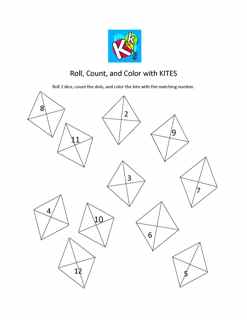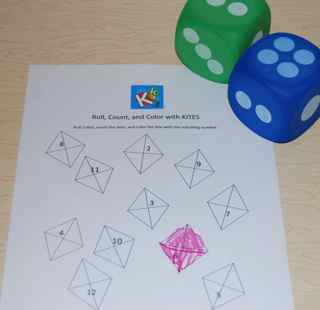The following article comes from our friends at The Preschool Toolbox. Co-founder, Darla Hutson, shares the step-by-step process on how to make fun spring math activities for preschoolers.
Spring Math Activities for Preschoolers: Pony Beads Kite
Pony Bead Kites are a fun way for preschool and kindergarten children to learn basic math concepts in a hands-on way!
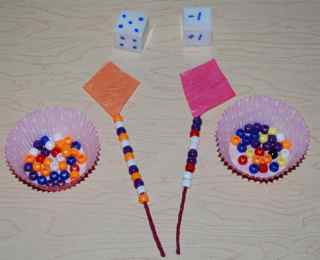
Materials Needed
2 blank foam, wood, or plastic cubes, permanent marker (for labeling the cubes), Wikki Stix or pipe cleaners (one per student playing), tape (if using pipe cleaners), assorted pony beads, small cups (cupcake liners work great), white paper, scissors, and crayons/markers.
Prior to the Game
Label one blank cube with dots to represent the numbers 1-6 on each of the six sides (a game die can also be used). Label the second blank cube with either a (-1) or a (+1 ) on each side. Have each child draw a kite shape on a piece of paper, color the kite, and cut it out (the Kites Template linked below can also be used). The children can then tape the kite shape to the top of a pipe cleaner (if using Wikki Stix, no tape will be necessary). Set out small cups with assorted colors of pony beads for the children to use as counters.
*Note: Supervise younger children closely when using small objects as they present a choking hazard.
How to Play the Game
Introduce the game as a large group activity. After the introduction, the game can be played with partners or in small groups.
The children should take turns rolling both of the labeled cubes. The children must count the number of dots rolled on one cube and either ADD 1 or SUBTRACT 1 (as indicated by the 2nd labeled cube) from the number of dots shown on cube #1 (see photo above).
When the children have the sum of the problem (number of dots +1 or – 1), they must count that number of pony beads and place them on the kites. As the children gain confidence in rolling the cubes, counting the dots, and adding or subtracting one, ask the children to verbally explain the problem as they place the beads on their kites (for ex: 6 + 1 = 7, so 7 beads must be placed on the kite).
The game is over when the children reach a pre-determined number of beads on their kites or when one pipe cleaner/Wikki Stix is filled with beads.
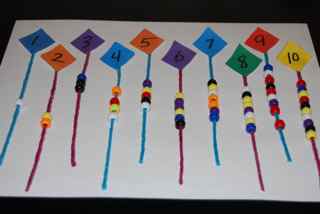
There are many variations of this game and other spring math activities for preschoolers that can be played with your students.
Five suggestions to enhance math skills are:
1) Label the kites with any numbers the children have had introduced. Ask the children to place the corresponding number of pony beads on the pipe cleaners (see photo above).
2) Label 10 kites with the numbers 1-10. Have the children work as a group to place their kites in the correct order – 1-10. Variation: Label the kites with the numbers 5-15 and have the children work to place the kites in the correct number order (starting at a number OTHER than 1).
3) Label 10 kites with the number 10. Have the children place 10 pony beads on each of the kites. The kites make great “10 bars” for counting to 100 by 10’s. For younger children, label the kites with various numbers for practice with skip counting by 2’s and 5’s. Hint: Print the Kite Templates below and laminate before cutting out. Dry erase markers can then be used to change the numbers/activities as required.
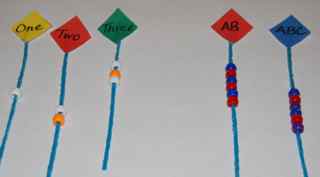
4) Write number WORDS on the kites. Have the children place the corresponding number of beads on their kites. It helps the children understand that the number name refers to a specific quantity of beads.
5) Write any basic pattern on the kites. Have the children create those patterns with the pony beads. For older children: Let the children use assorted pony bead colors to create more complex patterns.
Diamond Patterns to download and print for use with any of the suggestions above.

Kites Roll, Count, and Color
Materials Needed
One file (linked above) per student, 2 dice per student, and crayons/markers.
Print the Kites Roll, Count, and Color file (linked above) for each of the children. Have the children roll 2 dice, count the total number of dots, and color the kite with the corresponding number. The children should continue taking turns until all of the kites are colored.
Variation for Two Players
The 2 players should choose to be either EVEN or ODD numbers. Have one child color kites for the EVEN numbered rolls and the second child color the kites for the ODD numbered rolls. If the EVEN player rolls an ODD number, no kite is colored on that roll. The ODD player would then attempt to roll an ODD number. If he does not, no kite can be colored in. Play would continue until all the kites are colored.
Whether your children are learning at home or in the classroom this spring, we hope the spring math activities for preschoolers above will offer some creative inspiration! If you have additional suggestions for pony bead math activities, we’d love to hear about them. Leave a comment below to share with others!
Darla Hutson is a co-founder of The Preschool Toolbox and has owned a licensed group childcare/preschool home for the past 28 years. Darla has a passion for creating environments and activities that help facilitate play and learning for young children. She writes primarily at The Preschool Toolbox but you will also find spring math activities for preschoolers, kids, teachers, and families with young children at Squidoo and Sixty Second Parent.


